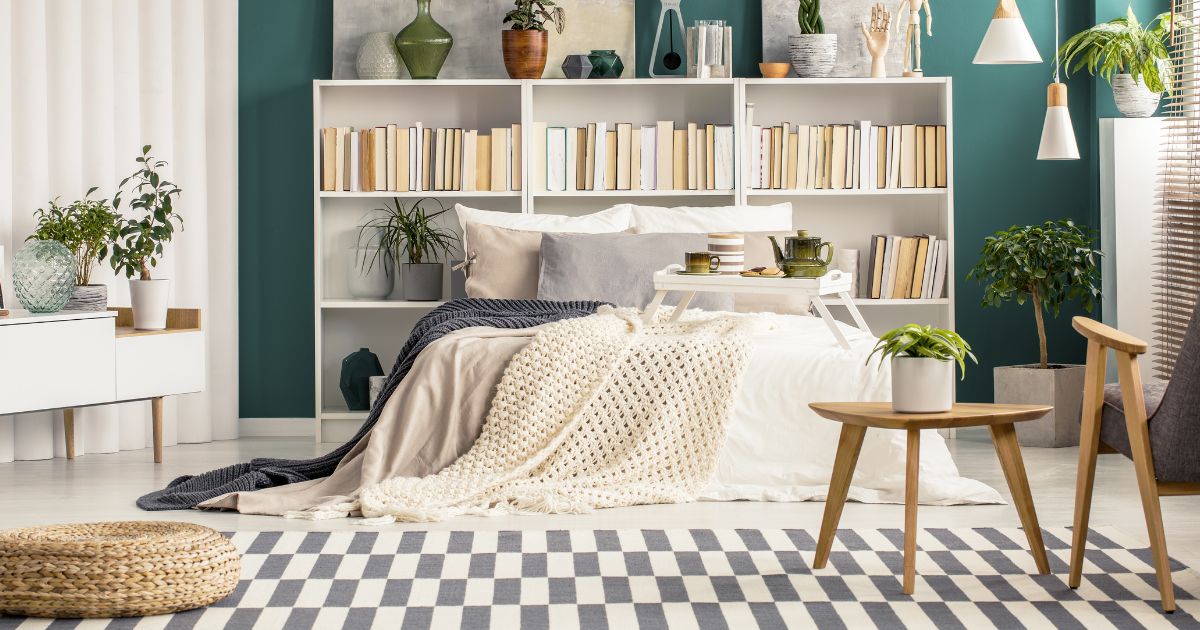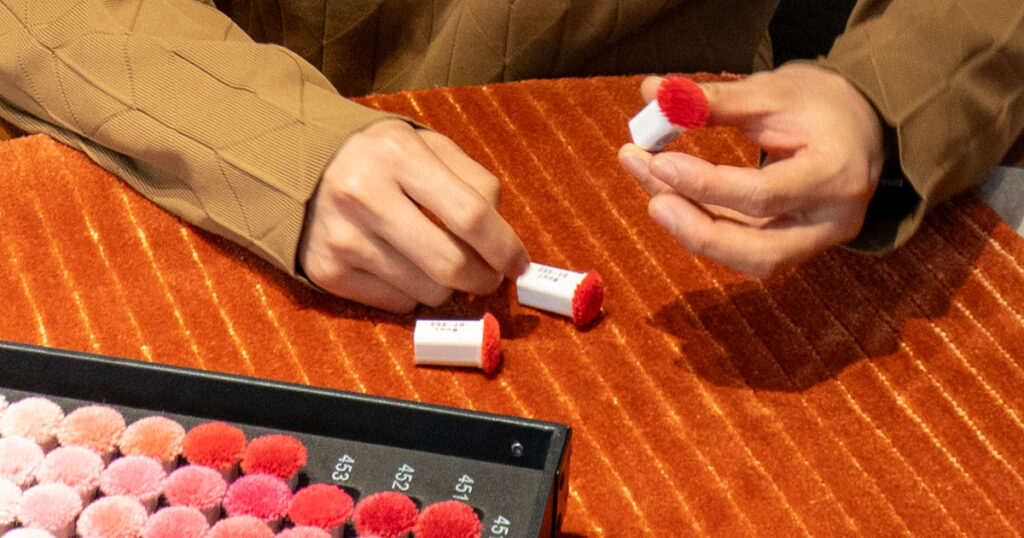This guide unveils everything you need to know about checkerboard patterns on tufted rugs.
Discover why these eye-catching designs are trending in home decor.
Learn about the unique tufting process, material choices, and styling tips.
Explore how to select the perfect checkerboard rug for your space and maintain its beauty for years.
Ready to transform your floors?
Let’s dive in!
Introduction
Checkerboard patterns on tufted rugs have become a popular trend in interior design, offering a bold and eye-catching element to any room.
This classic pattern, characterized by alternating squares of contrasting colors, brings a sense of order and visual interest to floor coverings.
Tufted rugs with checkerboard designs are versatile enough to complement various decor styles, from traditional to modern, making them an attractive choice for homeowners and interior designers alike.
What is a Tufted Rug?
A tufted rug is a type of floor covering created by punching or “tufting” yarn through a backing material, typically made of cotton or synthetic fabric.
- This process forms loops on the surface, which can be left intact for a looped pile or cut to create a cut pile.
- Tufted rugs differ from hand-knotted rugs in their construction method and usually take less time to produce, making them more affordable.
- They also offer more design flexibility compared to machine-made rugs, allowing for intricate patterns like checkerboards.
The Allure of Checkerboard Patterns
Checkerboard patterns have a rich history dating back to ancient civilizations, symbolizing duality and balance.
- In modern interior design, they’ve experienced a revival, appreciated for their ability to add visual interest and structure to a space.
The pattern’s versatility allows it to seamlessly integrate into various design styles:
- Traditional: Classic black and white checkerboard for a timeless look.
- Contemporary: Bold color combinations for a modern twist.
- Eclectic: Irregular checkerboard patterns for a unique, artistic feel.
Types of Checkerboard Patterns in Tufted Rugs
Checkerboard patterns in tufted rugs come in various styles:
- Classic black and white: The most iconic and versatile option.
- Colorful variations: Combining complementary or contrasting colors for a vibrant look.
- Irregular and asymmetrical designs: Offering a more relaxed, artistic interpretation of the pattern.
- Textured checkerboards: Incorporating different pile heights or materials for added dimension.
Materials Used in Checkerboard Tufted Rugs
Common materials for tufted checkerboard rugs include:
- Wool: Durable, naturally stain-resistant, and luxurious
Acrylic: Affordable, resistant to fading, and easy to clean - Polyester: Soft, stain-resistant, and budget-friendly
- Nylon: Extremely durable and easy to maintain
- Silk or viscose: Used for adding sheen and softness, often blended with other fibers
Each material has its pros and cons in terms of durability, maintenance, and cost.
For example, wool is highly durable but more expensive, while synthetic fibers are more affordable but may not have the same longevity.
The Tufting Process for Checkerboard Rugs
The tufting process for checkerboard rugs involves several steps:
- Design creation: The pattern is mapped out on a scaled grid.
- Backing preparation: A sturdy fabric is stretched on a frame.
- Tufting: Yarn is punched through the backing using a tufting gun or machine.
- Cutting: For cut-pile rugs, the loops are sheared to create a smooth surface.
- Finishing: A latex coating is applied to the back to secure the tufts.
- Binding: Edges are finished to prevent fraying.
Skilled craftsmanship is crucial in ensuring even tension, consistent pile height, and precise color placement for a flawless checkerboard pattern.
Sizing and Placement
Standard sizes for tufted checkerboard rugs typically include:
- 2′ x 3′ (small accent rug)
- 4′ x 6′ (medium area rug)
- 5′ x 8′ (large area rug)
- 8′ x 10′ (room-sized rug)
- 9′ x 12′ (oversized room rug)
When choosing a size, consider:
- Living rooms: Leave 12-18 inches of floor space around the rug’s edges.
- Dining rooms: Ensure the rug extends at least 24 inches beyond the table on all sides.
- Bedrooms: Place runners on either side of the bed or use a large rug that extends beyond the bed’s sides and foot.
Color Theory and Checkerboard Rugs
When selecting colors for a checkerboard rug:
- Consider the room’s existing color palette
- Use the 60-30-10 rule: 60% dominant color, 30% secondary color, 10% accent color
- Opt for complementary colors for a bold look or analogous colors for a more harmonious feel
- Remember that lighter colors make a space feel larger, while darker colors add coziness
- Maintenance and Care for Tufted Checkerboard Rugs
To maintain your tufted checkerboard rug:
- Vacuum regularly, at least once a week
- Rotate the rug every 3-6 months to ensure even wear
- Clean spills immediately by blotting, not rubbing
- Use professional cleaning services annually for deep cleaning
- Consider applying a stain-resistant treatment for added protection
Comparing Tufted Checkerboard Rugs to Other Styles
Pros of tufted checkerboard rugs:
- More affordable than hand-knotted rugs.
- Offer greater design flexibility than machine-made rugs.
- Durable and long-lasting with proper care.
Cons:
- May not have the same prestige as hand-knotted rugs.
- Can be prone to shedding, especially when new.
Choose a tufted checkerboard rug when you want a bold, patterned look at a more accessible price point.
Styling Tips: Incorporating Checkerboard Tufted Rugs in Your Decor
- Living room: Use a large checkerboard rug as a focal point, pairing it with solid-colored furniture
- Dining room: Place a round table on a square checkerboard rug for an interesting contrast
- Bedroom: Add a checkerboard runner at the foot of the bed for a pop of pattern
- Kitchen: Use a small checkerboard rug in front of the sink or stove for both style and comfort
Customization Options
Many manufacturers offer customization options for tufted checkerboard rugs:
- Choose your own color combinations
- Adjust the size to fit your specific space
- Select different materials or pile heights
- Incorporate brand logos or personal designs into the pattern
The process typically involves consulting with a designer, approving a sample, and waiting 6-12 weeks for production.
Price Range and Value Considerations
Factors affecting the cost of tufted checkerboard rugs include:
- Size
- Material (wool being more expensive than synthetic fibers)
- Complexity of the pattern
- Brand reputation
Expect to pay anywhere from $100 for a small, synthetic rug to $2000+ for a large, high-quality wool rug.
Consider the rug’s durability and your long-term needs when balancing quality and budget.
Environmental and Ethical Considerations
When shopping for tufted checkerboard rugs, look for:
- Use of sustainable materials (e.g., organic wool, recycled fibers)
- Low-VOC adhesives and dyes
- Fair labor practices
- Certifications such as GoodWeave, OEKO-TEX, or Green Label Plus
Conclusion
Checkerboard patterns on tufted rugs offer a timeless yet trendy option for homeowners looking to add visual interest and structure to their living spaces.
As we’ve explored throughout this guide, these rugs combine the affordability and design flexibility of tufted construction with the classic appeal of the checkerboard pattern.




